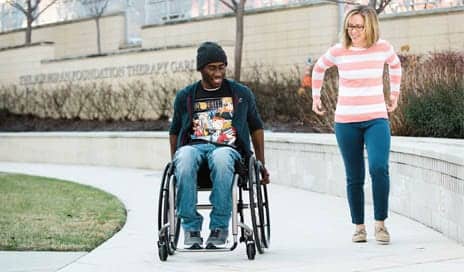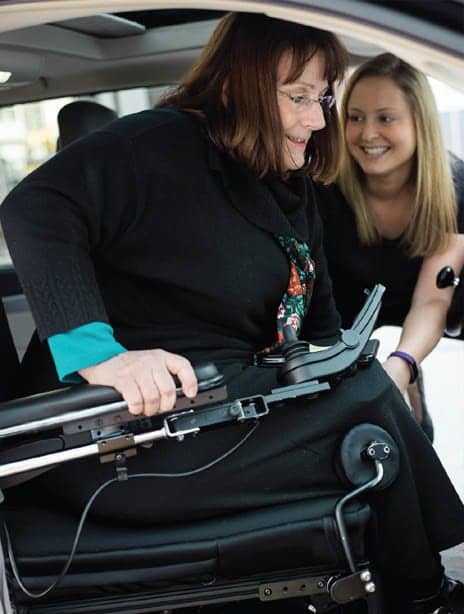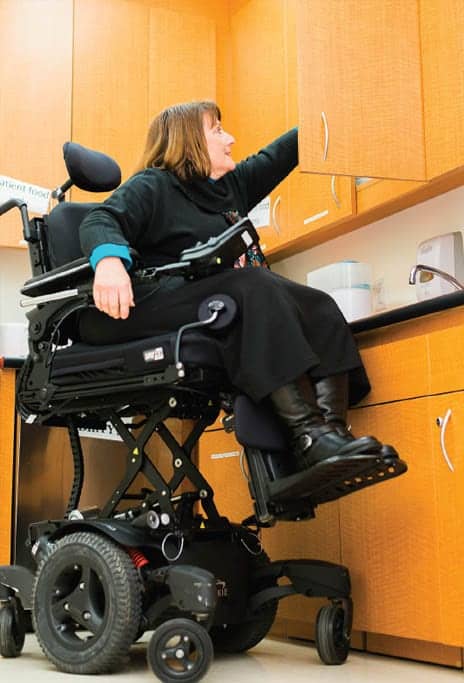
Overall weight is a moot point if the chair does not fit properly. Providers are now prioritizing performance of the chair, including configuration, propulsion efficiency, ride quality, and ease of use. Today, the fit of a manual chair can be highly individualized like that of a prosthetic.
by Erin Michael, PT, DPT, ATP/SMS, and Meredith Budai, PT, DPT, ATP/SMS, CRND
The evolutionary course of technology in the wheelchair and seating industry has largely been driven by a mission to use technology advances to improve how mobility devices meet client needs. Many of today’s mobility users have a need for a high level of engagement with their community and surroundings. Thus, an important aspect of the constant cycle of modifications are advances that improve safety and reliability of the equipment, thereby ensuring user compliance, independence, and improved quality of life. This article explores how those advances have kept the focus on the client and the improvements they bring to the mobility device user’s experience.
Manual Wheelchair Frame Material
Titanium and aluminum are the two most predominant materials, with carbon fiber rising in popularity. Aluminum is the cheapest, making it the most popular with payors. The recent transition to 7000-series aluminum, which is 23% stronger, allows a decrease in thickness of the tubing wall. This results in weights closer to titanium frames. Aluminum is stiff, allowing for optimal transfer of user power into propulsion. However, this stiffness can create a more uncomfortable ride, transferring road vibrations directly to the body. While titanium and carbon fiber each have vibration-dampening qualities, titanium has the highest strength-to-weight ratio of any metal—and it’s bulletproof. Meanwhile, carbon fiber is the lightest of the three. It can also be customized to maximize strength by laying strands in specific directions and assessing individual molds for optimum strength profiles. Carbon fiber appears to be the best of all worlds: high strength and stiffness, combined with natural shock absorption qualities and the lightest weight. It is also the most expensive, however, which limits funding options.
Frame Design: Rigid Versus Folding
A rigid frame is more energy-efficient and, generally, lighter in weight. There is less flex of the frame, allowing more of the user’s energy to go into forward motion. Additionally, fewer parts are required to hold the frame together, decreasing overall weight and maintenance. The rigid style can be made stronger with a dual tube design, allowing for even thinner tubing. Evolving engineering practices are leading to innovate folding frame designs. There are now manufacturers creating “ultra-rigid” folding mechanisms, which decrease overall flex, and newer designs are utilizing fewer and lighter linking pieces.
Tilt-in-space frames have evolved into models that are lightweight and compact. These advances have been aimed at making manual chairs easier to push and easier to adjust. Some models are made to offer very precise rotational orientation with tilt arcs that telescope from 0° to 50° and lock in 2° increments. For pediatric manual wheelchair users, some of the latest tilt-in-space seat frames can adjust in width to accommodate growth changes. They likewise are designed for seat frames to adjust horizontally to adjust users’ body weight for easier tilt functions as well as adjust vertically to lower seat heights for transfers.
Configuration
Overall weight is a moot point if the chair does not fit properly. Imagine having a bicycle made of carbon fiber, but being unable to reach the pedals or not knowing how to shift gears. Providers are now prioritizing performance of the chair, including configuration, propulsion efficiency, ride quality, and ease of use. Today, the fit of a manual chair can be highly individualized like that of a prosthetic.
Safety and reliability of the system is highly dependent upon wheel position. A more forward position of the axle decreases overall rolling resistance, allows easier negotiation of variable terrain, and limits the risk of upper extremity strain or injury over time. Yet, an axle that is too far forward can result in injury from tipping backward. Moreover, inadequate caster formation or frame length can result in the user falling out of the chair forward.
There have been notable innovations to improve propulsion efficiency and ride quality. One of those innovations is a rear wheel that requires pulling backward on the handrim to roll forward. This utilizes the larger, stronger muscles of the back and promotes a more upright posture. A second is a rear wheel with a built-in suspension system, promoting absorption of energy through the wheel, instead of through the user’s spine. The shocks are specially designed to remain rigid over flat terrain, while engaging on variable terrain or when doing curbs.
Power assist systems have become much lighter, decreasing strain when lifting them. Moreover, a system now exists that drastically reduces the quantity of propulsive strokes. With the first stroke a motor engages and keeps the chair going until the user decides to stop or needs to stop.
Ride quality can also be heavily impacted by tire choice. A flat-free design decreases maintenance, but makes the ride bumpier. If the user lives in a variable climate or enjoys being outdoors, a knobby tire with deeper treads may be considered. These tires have increased rolling resistance, so it is not recommended that they serve as the primary wheel.

A client-centered approach can guide the evaluation and equipment recommendation process, ensuring that the technology best meets the user’s needs.
Power Drive Wheels
A power wheelchair base can be set up in one of three configurations: mid-wheel drive, front-wheel drive, or rear-wheel drive. Historically, rear-wheel drive configurations were most available. However, they have an expansive footprint, resulting in a large turning radius and accessibility issues. This led to the development of mid-wheel and front-wheel drive technologies. A mid-wheel drive wheelchair is the most maneuverable as it has the tightest turning radius and smallest 360-degree turning circumference, making it a great indoor wheelchair. Front-wheel drive wheelchairs navigate tight corners better due to the small front end but make turning 360 degrees difficult due to the long back end. The location of the large drive wheels at the front of the base allows it to traverse obstacles with ease, making it a great wheelchair for variable terrains.
Power Wheelchair Safety
To improve overall drivability, complex power wheelchair manufacturers have developed improved suspension systems. These absorb the vibration transmitted when traversing over uneven or rough terrain. This is notably important to improve the consumer’s safety. For instance, these are beneficial for users with spasms triggered by a bumpy ride. In mid-wheel drive wheelchairs the technology has improved to ensure placement of front and rear casters on the ground at all times, reducing the potential for instability.
Tracking technology is also available on most complex power wheelchairs. This technology prevents wheelchairs from veering off the desired course. If drive wheels or casters become displaced when traversing over rough terrain, transitioning between terrain types, or when on slopes, this technology ensures that the chair rights itself to stay on course. This is especially helpful for nonproportional drive controls (ie, sip and puff and head array) because it reduces compensatory switch activation and user fatigue.
Other capabilities to note include light packages, ability to charge phones, tablets and ventilators, and integrate with phones or other home devices. Multiple manufacturers have transitioned to LED lights, which are brighter and longer lasting. Light packages provide increased visibility at nighttime and may allow the user to see around them in a power outage or if they cannot access the light switch. Manufacturers are now adding Bluetooth capabilities and USB ports to the joysticks, allowing phones or tablets to be controlled by the drive mechanism and charged while in the chair. In combination with new applications, this can lead to control of many other devices in the home. This is especially important for a user who does not have the hand or arm function to access these devices otherwise.
Power Wheelchair Seating
Complex power seating provides the opportunity for the consumer to tilt and recline in space, elevate lower extremities, assume an elevated seat position, and even stand. These seat functions improve consumer safety by decreasing the risk of potentially debilitating medical conditions including decubitus ulcers, contractures, upper extremity injury, and pain. Evidence has shown us that these seat functions perform better together than individually, so manufacturers have improved capabilities for the coordination of these functions. For example, if it is determined that a user achieves the greatest pressure relief with a combination of specific tilt, recline, and leg elevation angles, the chair can be programmed to achieve the desired position with the touch of a button. This position change can be latched, improving convenience and likelihood of compliance.
Power seating technology is also expanding to include pressure relief reminders. A customized program, including frequency, time, and seat position, can be made. The chair alerts the user that it is time and, if the user agrees, the chair automatically assumes the preprogrammed position. The best part for the provider: the systems track use, allowing them evidence of effective (or not) participation.
The technologies for seat elevators have improved significantly. Previously, seat elevators required the end user to stop, elevate, and then resume driving. They also greatly reduced the speed at which the user could drive. The newer technologies allow users to continue driving while actively elevating and maintaining higher speeds, eliminating disruption to their participation. Additionally, the user can obtain up to 14 inches of elevation, which greatly improves functional reach and social interaction.

The technologies for seat elevators have improved significantly. Some current technologies enable users to obtain up to 14 inches of elevation, improving functional reach and social interaction.
Seating System
Cushion materials have not changed much in recent years; however, configurations have. Hybrid designs promote balance of the pros and cons of each material, improving the user experience. For example, foam is used at the anterior of the cushion to provide a more rigid surface for transfers, while air or gel can be used under higher risk areas, like the ischials. In extreme temperatures, air and gel are going to perform differently. In high heat, air expands and gel becomes more fluid; the opposite occurs in low heat. This will impact how the user sits in the cushion and his or her overall skin protection. A solid backrest provides greater postural support, but can add significant weight to a manual chair. Design innovation continues to maximize strength and adjustability, while reducing weight.
Wheelchair and seating technologies are constantly changing, evolving with the times. It can seem overwhelming to keep track of the changes and to know what products are best for the end user. Thus, it is important to have a relationship with suppliers and/or manufacturer representatives to keep abreast of the changes. A client-centered approach can guide the evaluation and equipment recommendation process, ensuring that the technology best meets the user’s needs. RM
Erin Michael, PT, DPT, ATP/SMS, is Manager of Patient Advocacy and Special Programs at Kennedy Krieger Institute’s International Center for Spinal Cord Injury in Baltimore. She received her Doctor of Physical Therapy Degree from Ithaca College in 2006. She specializes in treating paralyzing neurological conditions, including multiple sclerosis, transverse myelitis, cerebral palsy, and traumatic and non-traumatic spinal cord injury. Additionally, Michael is the coordinator of the ICSCI Seating and Mobility Clinic and has specialized in seating and mobility for nearly 10 years. She received her assistive technology professional certification in 2011 and her seating and mobility specialist certification in 2013. Michael is a member of the Clinician’s Task Force and of the RESNA Professional Standards Board. She previously held the position of vice-chair of the Seating and Wheeled Mobility SIG of RESNA for 3 years.
Meredith Budai, PT, DPT, ATP/SMS, CRND, is a clinical specialist at the International Center for Spinal Cord Injury at Kennedy Krieger Institute in Baltimore. She received her bachelor of science and bachelor of health sciences in 2006 and her Doctorate of Physical Therapy in 2008 from Duquesne University in Pittsburgh. Budai has been a certified assistive technology professional since 2011, a certified seating and mobility specialist since 2015, and is on the board of examiners for rare neurological disorders. For more information, contact [email protected].



